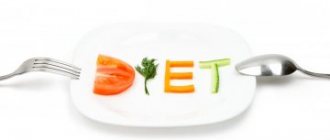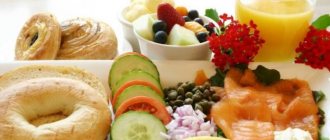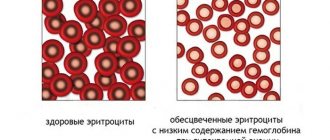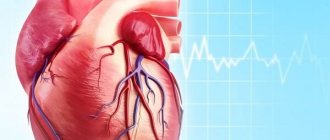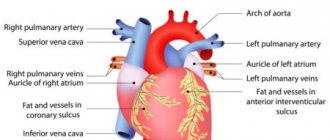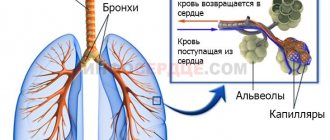Introduction
Chronic heart failure (CHF) is a complex syndrome caused by one or another disease of the circulatory system, the essence of which is an imbalance between the hemodynamic needs of the body and the capabilities of the heart.
Clinically, CHF is manifested by five main signs:
- shortness of breath;
- rapid heartbeat;
- fatigue;
- decreased physical activity;
- fluid retention in tissues (edema).
Simply put, CHF is the inability of the heart to provide blood to tissues in accordance with their metabolic needs at rest and under moderate stress, in the absence of hypovolemia and reduced hemoglobin.
Modern principles of nutrition for a patient with CHF
An essential factor in the treatment and prevention of cardiac diseases is a rational and balanced diet. An incorrectly composed daily diet is a fundamental link that causes the development of excess body weight, lipid metabolism disorders and carbohydrate tolerance, hypertension, and atherosclerosis. Which in turn increases the risk of myocardial infarction, stroke, arrhythmias and, as a consequence, CHF.
Chronic heart failure is not an independent pathology. This is a consequence of a long-term illness that has weakened the myocardium.
The main causes of CHF are one or a combination of the following pathologies:
- consequences of coronary heart disease (CHD), caused by atherosclerosis;
- arterial hypertension;
- valve defects (mitral, aortic, tricuspid);
- cardiomyopathies, inflammatory heart diseases;
- rhythm disturbances (usually atrial fibrillation);
- diseases of the endocrine system: diabetes mellitus, hypo-, hyperthyroidism, Addison's disease, Conn's disease);
- alcoholism.
The diet of a person with cardiovascular diseases can contribute to:
- reducing the load on the myocardium and blood vessels;
- slowing down pathological changes in the vascular wall, improving their elasticity;
- reducing blood cholesterol levels;
- preventing the appearance of edema, which significantly impedes the normal functioning of the cardiovascular system;
- improving metabolism;
- reducing the required daily dosage of drugs for the treatment of CHF.
Nutritional therapy is determined by a combination of many factors:
- food selection;
- determining the ratios of individual products and nutrients;
- optimal cooking methods;
- degree of grinding;
- meal schedule;
- calorie intake.
In order for nutrition for CHF to create an optimal background to enhance the effect of the main types of treatment and prevent the progression and complication of the disease, it is necessary to create a daily menu in such a way that:
- the patient fully received the necessary nutrients, taking into account existing diseases;
- a set of recommended products could be purchased at a reasonable price;
- the dishes were varied and relatively easy to prepare;
- individual intolerance and preferences of the individual patient were taken into account;
- the diet was divided into 4-6 meals, and no more than 25% of the daily amount of food should be consumed in the evening.
I recommend that my patients buy scales for home and monitor their body weight 2-3 times a week. Gaining 2-3 kilograms in 3 days indicates fluid retention and requires consultation with a doctor and adjustment of the treatment regimen.
Weighing is also necessary for patients with concomitant obesity. A loss of 10% of initial body weight leads to a decrease in blood pressure by 5 mm. rt. Art., reducing the load on the heart, shortness of breath, joint pain, increasing tissue utilization of glucose.
What products to exclude
The American Heart Association (AHA) identifies sodium and water as the main substances to limit in heart failure.
Sodium is a mineral that is found in many foods, especially processed foods, fast food, and salt. It promotes water retention in tissues, volume overload of the vascular bed, increased blood pressure, and cardiac decompensation.
The AHA recommends consuming no more than 2,800 mg of sodium daily (and ideally less than 1,500 mg).
Even a salt-free diet does not guarantee that a person does not exceed the daily amount of sodium.
The most hidden salt is found in sausages, marinades and pickles, canned food, ready-made frozen dishes, cheeses (Parmesan, Cheese, Feta, Russian, processed), soy sauce, mayonnaise.
Water. Limitation of fluid intake for patients with hemodynamically stable CHF is moderate - up to 1.5-2 liters per day. In case of cardiac decompensation and edema syndrome, requiring intensive use of diuretics, the daily amount of water should not exceed 1-1.2 liters.
Patients with diseases of the cardiovascular system are recommended to exclude:
- fast food, semi-finished products, canned food;
- fried in oil, hot, spicy food;
- pickles and marinades;
- concentrated meat broths;
- fatty meats, offal, sausages, frankfurters;
- strong tea, coffee;
- alcohol, tobacco.
Karelian diet
The Karelian diet is used in cases where the patient suffers from a severe form of heart failure. It is also often prescribed to people diagnosed with heart disease. Compliance with this diet allows you to eliminate swelling, eliminate dropsy of the sternum and abdominal cavity.
First of all, with this diet, fluid intake is limited. Milk is recommended in an amount of no more than 1 liter per day in 8-10 doses. Solid food should be added gradually. The approximate diet for week 3 includes:
- bread;
- curdled milk;
- eggs;
- meat (in small quantities);
- potato.
After the specialist notes an improvement in the condition, the patient can be transferred to a gentle diet, such as diet No. 10a.
If a patient suffers from atherosclerosis in the stage of heart failure, approximately 60% of the products from the menu of healthy people are used. You will have to give up foods high in vitamin D and cholesterol. These include:
- liver;
- kidneys;
- fatty fish;
- egg yolk;
- brain;
- pork products.
In terms of calorie content, the table is limited to 2700 kcal/day. In this case, foods rich in lipotropics would be preferable. Choline and methionine stimulate the heart and help cleanse the body of excess cholesterol. Products containing a large number of lipotropics include:
If the patient’s condition improves, the “Table No. 10” diet can be applied. Let’s consider it in more detail.
Important Diet Elements
The daily menu of a patient with CHF must first of all be balanced with respect to proteins, fats, carbohydrates, cover energy costs, and be rich in microelements important for the heart.
Squirrels. An important structural element of cells. It is recommended to eat 2-3 servings of protein daily.
Equivalent to one serving:
- 100 grams of fish, meat (lean beef, veal, poultry);
- ? cups of boiled beans or peas;
- 1 egg.
It is necessary to limit proteins in the diet only in case of renal failure and azotemia.
Dairy products. The optimal amount is 2-3 servings:
- 100 grams of cottage cheese;
- 1 glass of milk with 1-2% fat content;
- 1 glass of kefir, fermented baked milk, yogurt, yogurt without additives;
- 2 tbsp. l. sour cream with a fat content of no more than 15%.
Vegetables and fruits. This is an important part of the diet, which provides the body with fiber, pectin, microelements, vitamins and is low in calories.
You need to eat 5 servings per day:
- ? cups chopped fruit (fresh or baked);
- ? cups of boiled or baked vegetables.
Porridge and bread . This part of the diet is responsible for energy saturation of the body. Preference should be given to slow carbohydrates, eating 5 servings daily:
- 1 slice of whole grain bread;
- ? cups of pasta;
- ? cups of rice, buckwheat, oatmeal and other cereals.
Unsaturated fats and oils. The body needs to get the “right” fats, as this is the building material of all cell membranes. For cooking and dressing salads, it is optimal to use refined oils (olive, corn, sunflower, flaxseed).
A good source of healthy fats are nuts (dried, unseasoned). You can consume 1 handful (40 grams) per day.
To give food a brighter taste, salt can be replaced with aromatic herbs (parsley, basil, oregano, rosemary, cumin, cilantro), garlic, onion, lemon juice, paprika.
Patients with atherosclerosis should pay special attention to the amount of dietary fiber in the diet (as they prevent the absorption of fatty acids from the intestine). Men need 76 grams per day, and women – 28 grams.
Also, if it is impossible for my patients to fully saturate their diet with the necessary vitamins and microelements, I recommend taking courses of beekeeping products and nutritional supplements enriched with potassium, magnesium, zinc, calcium, phosphorus (vitamins A, C, E, B1, B2, B6).
Regarding temperature treatment: it is better to boil, stew or bake foods for heart failure. Cooking on a grill and in a Teflon-coated frying pan is allowed, without oil.
Proper nutrition and diet for heart failure
/ Health / Diet / Medical / Heart / Proper nutrition and diet for heart failure
Heart failure occurs when the heart does not work efficiently and does not deliver enough oxygen to the body. An unhealthy diet only worsens the symptoms of the disease.
If you eat too much salt or drink too much fluid, your body's water content increases and your heart works harder. The following diet recommendations will help reduce the negative factors associated with the disease.
Nutrition for swollen legs
Patients need to carefully approach not only the choice of food, but the very process of eating. The following recommendations will help improve the condition of people suffering from heart problems in order to prevent leg swelling:
- Water balance. The maximum amount of liquid per day should not exceed 0.8-1 liter.
- Salt. You are allowed to consume no more than 2-4 grams per day, depending on body weight. If the swelling is very large, then it is better to exclude salt from the menu completely.
- Fractional meals. The key to good health is dividing the daily food intake into the maximum possible number of servings. For heart failure, it is recommended to eat 5-6 times a day.
- Food processing. The dish should be easily digested by the gastrointestinal tract. If meat - then in the form of steamed cutlets or meatballs, fruits and vegetables - in the form of freshly squeezed juices and purees.
- Taking vitamins and microelements. The amount of nutrients that a person receives with food is often insufficient, so nutritionists and doctors advise taking additional vitamin and mineral complexes.
It is worth noting that heart failure most often occurs in older people.
Karelian diet
In case of heart failure, experts advise paying attention to the Karel diet. This salt-free diet is often used for weight loss.
The basic principle of such nutrition is to improve blood circulation and metabolism, remove excess fluid from the body and have a diuretic effect.
Karel's diet is not easy and many people cannot stand it, however, when health is at stake, there is nowhere to go.
Attention! Before you start eating according to this plan, you need to consult your doctor!
The step-by-step application of the diet is presented below:
- 1 day. From 8 am, drink half a glass of boiled warm milk every two hours. Duration: 7 times a day. At 10 pm, drink 100 ml of freshly squeezed juice of your choice.
- Day 2. In the morning, eat a piece of bread (100-150 grams) and one soft-boiled egg. Every two hours – 100 ml of milk. At 2 p.m., boiled rice with butter is served for lunch and washed down with 100 ml of milk, which is then drunk every two hours. At 10 pm - juice.
- Days 3 and 4. In the morning you need to eat a piece of bread, a soft-boiled egg and a little butter. At 10 and 12 o'clock you should drink milk (150 ml). At 2 p.m., eat mashed potatoes with butter and drink milk (half a glass). Continue drinking milk every two hours. In the evening before going to bed at 10 pm you need to drink 100 ml of juice.
- 5-7 days. In the morning, eat 200 grams of bread, one boiled soft-boiled egg, one small baked apple and 100 ml of milk. After two hours - half a glass of milk. At 12 o'clock you need to eat 200 grams of mashed potatoes with butter and 100 ml of milk. Continue drinking milk until the evening, and eat one boiled egg at 6 p.m. Before bed - juice.
Chronic form (CHF)
If the disease is chronic, then the diet must be followed constantly. It is not as heavy as the Karel diet, but it also has its own rules and restrictions.
//www.youtube.com/watch?v=OLk6zaOq8VQ
In case of CHF, it is important to maintain the water-salt balance of the body.
What can you eat?
What foods should you eat? The menu should be enriched with potassium (a mineral that has a positive effect on the heart muscle), contained in the following products:
- potato;
- legumes;
- banana;
- dried apricots, prunes, raisins;
- avocado;
- salmon;
- spinach, parsley;
- tomatoes;
- pumpkin;
- oranges.
Interesting article: Heart-healthy foods rich in potassium and magnesium
You can prepare many delicious and healthy dishes from these products. Nutritionists also advise adding vitamin C to your diet, which is found in:
- rosehip decoction;
- black currant;
- citrus fruits;
- kiwi.
B vitamins, calcium, magnesium, iron, and phosphorus are also needed.
Food restrictions
If you have heart failure, you will have to give up many of your usual foods. The ban on such dishes is due to the large amount of salt in them.
Prohibited foods include:
- Pickled vegetables. It's better to switch to fresh salads. They are much more useful.
- Pickles. Salted vegetables, meat, fish - all these delicacies are also now prohibited. Nutritionists advise preparing other dishes from these products.
- Canned food. They also contain a high salt content, which is difficult to control.
- Smoked meats. Sausages, wings and other smoked foods are difficult for the intestines to digest and contain a lot of salt.
- Alcohol. Alcoholic drinks increase swelling by retaining water in the body.
- Snacks. Store-bought crackers and chips are another type of harmful food for people suffering from heart failure.
- Coffee. This drink also retains liquid. It is better to switch to rose hips, rich in vitamin C, or green tea, but not to chicory.
- Confectionery products made from white flour, as well as other sweets (soda, cakes, chocolate). These delicious foods also need to be eaten in doses.
Menu for every day
The following is a sample menu for the week, which will be especially useful for women:
1 day
- Breakfast - green tea, cottage cheese with dried fruits, boiled egg.
- Second breakfast - a glass of kefir, a handful of currants or citrus fruit.
- Lunch - bean soup with chicken broth, mashed potatoes, salad of fresh vegetables and herbs, bread, freshly squeezed juice.
- Afternoon snack - fruit salad topped with yogurt.
- Dinner - buckwheat porridge, omelette with milk, chopped vegetables, tea.
Day 2
- Breakfast - oatmeal with milk with dried fruits, a sandwich with cheese and butter, green tea.
- Second breakfast - a glass of milk, an apple.
- Lunch - rice soup, noodles with chicken chop, salad of fresh vegetables and herbs, bread, freshly squeezed juice.
- Afternoon snack - tea, baked pumpkin, 25 g of dark chocolate, banana.
- Dinner - vegetable casserole, a piece of boiled fish, bread, rose hip decoction.
Day 3
- Breakfast - milk soup with noodles, boiled egg, green tea.
- Second breakfast - a glass of yogurt, oatmeal cookies.
- Lunch - fish soup, pearl barley porridge with beef meatballs, salad of fresh vegetables and herbs, bread, freshly squeezed juice.
- Afternoon snack - cottage cheese with dried fruits, kiwi.
- Dinner - boiled potatoes, stewed chicken liver, chopped vegetables, tea.
4 day
- Breakfast - cottage cheese casserole, boiled egg, green tea.
- Second breakfast - a glass of milk and a banana.
- Lunch - buckwheat soup, pumpkin puree with turkey cutlets, salad of fresh vegetables and herbs, bread, freshly squeezed juice.
- Afternoon snack - baked apples, hard cheese, tea.
- Dinner - stewed beans with vegetables, bread, tea.
5 day
- Breakfast - omelet with milk, green tea.
- Second breakfast - a glass of kefir, biscuits.
- Lunch - pea soup, potato and beef stew, salad of fresh vegetables and herbs, bread, freshly squeezed juice.
- Afternoon snack - fruit salad topped with unsweetened yoghurt.
- Dinner - boiled beef tongue, chopped vegetables, tea.
Day 6
- Breakfast - cottage cheese with dried fruits, boiled egg, green tea.
- Second breakfast - a glass of sourdough, a handful of nuts.
- Lunch - fish soup, rice porridge with chicken meatballs, salad of fresh vegetables and herbs, bread, freshly squeezed juice.
- Afternoon snack - potato pancakes with sour cream, banana.
- Dinner - milk buckwheat porridge with sugar, tea.
Day 7
- Breakfast - semolina porridge with milk, boiled egg, green tea.
- Second breakfast - a glass of fruit juice, 25 g of dark chocolate.
- Lunch - mushroom soup, millet porridge with beef liver, salad of fresh vegetables and herbs, bread, freshly squeezed juice.
- Afternoon snack - sliced fresh fruit.
- Dinner - stewed vegetables, a piece of boiled salmon, tea.
Interesting article: Table 10 diet for cardiovascular diseases
We invite you to watch a video about heart failure with Dr. Myasnikov:
The main principle for heart failure is proper nutrition, which will help dramatically improve your well-being. Follow all the above recommendations, but do not forget to consult your doctor!
Source: //pitanie.plus/zdorove/dieta/lechebnaya/serdtse/nedostatochnost-s.html
Sample menu for the week
The DASH nutrition system, developed by the American Heart Association, is considered optimal for heart failure.
When drawing up an approximate 7-day menu for a patient with CHF, it is necessary to take into account the root cause of the disease and concomitant pathology. For example, if the causes of heart failure are coronary artery disease and atherosclerosis, special attention should be paid to limiting saturated fats and enriching the diet with pectin and fiber. And if you have diabetes, focus on eliminating foods with a high glycemic index.
There are low-sodium substitutes (Himalayan salt, Saga) that can give the dish a salty taste. Potassium chloride should only be used after consulting a doctor and monitoring serum K levels.
For my patients, I provide a list of recommended dishes, and they combine the diet themselves, taking into account taste preferences, the available range of products and individual culinary skills.
Clinical case
My patient N. is 64 years old.
History of hypertension stage III, 2nd degree. In 2020, he suffered an acute Q-myocardial infarction of the anterior wall of the left ventricle, complicated by cardiogenic pulmonary edema. At the time of the first visit in 2020, the patient complained of shortness of breath, worsening with physical exertion, rapid heartbeat, and swelling in the legs. Objectively: N. had class I. obesity (BMI - 34.4 kg/m2), blood pressure - 145/100 mm. rt. Art., heart rate - 89 beats/min. According to the examination results, hypercholesterolemia, hypokinesia of the anterior wall of the left ventricle, ejection fraction 40%. The patient constantly took Enap N, Concor, Furosemide, Cardiomagnyl, and drank Nitroglycerin during attacks. A diagnosis was made: CHF IIA, IIFC. It was recommended to adjust the lifestyle, give up tobacco and alcohol, and select a diet for heart failure for every day. Over the course of 2 years, the patient gradually adapted to the new diet. At the last appointment: BMI - 28.9 kg/m2, blood pressure - 136/85 mm. rt. Art., heart rate - 79 beats/min. Complaints of shortness of breath have decreased; episodes of using Nitroglycerin are no more than once a week. The patient notes a significant increase in physical activity. Based on the results of the consultation, Fr.
From the list, the patient selects 3 main meals and 2-3 snacks.
Breakfast
- Oatmeal, buckwheat, corn, rice porridge, 40 grams, cooked in milk and water in a 1:1 ratio with 1 tsp. honey, 1 boiled egg, herbal tea.
- Omelette of 2 eggs with milk 1-2% (100 ml), a slice of whole grain bread, an apple, tea.
- 300 grams of pumpkin-rice (or millet) pudding, 30 grams of hard cheese.
- 200 grams of cheesecakes with berries and 1 tbsp. l. sour cream or honey, cocoa and low-fat milk.
- Oatmeal pancake with 2 tbsp. l. oatmeal, 1 egg with 30 grams of hard cheese, fresh cucumber, tea.
- Vegetable muffins with green peas, green beans and bell peppers, tea.
Lunches
- Vegetable puree soup (300 grams), 100 grams of boiled meat, 1 slice of bread.
- Lenten borscht (300 grams), 100 grams of stewed or baked poultry, a slice of bread.
- Vegetable salad with vegetable oil, steamed cutlet with a side dish of porridge, compote.
- 100 grams of pasta with vegetable sauce, 100 grams of meat, fresh vegetables.
- Lentil soup, 300 grams, 100 grams of baked fish with vegetables.
Dinners
- 200 grams of baked fish with vegetable garnish.
- Peppers, eggplants or zucchini stuffed with chicken and baked in the oven.
- Vegetable salad with squid with lemon-mustard dressing, 1 slice of whole grain bread with 30 grams of cheese.
- Salad of boiled beans with vegetables, seasoned with vegetable oil or yogurt with herbs, whole grain bread.
- Vinaigrette with beans, dressed with olive oil.
- Steamed poultry cutlets with stewed cabbage.
- Baked potatoes in their skins with a sauce based on yoghurt, herbs and garlic with vegetable salad.
- Omelet with green beans, fresh vegetables.
Snacks
- A handful of dried nuts.
- Apple baked in the oven with honey, cinnamon and cottage cheese.
- 100 grams of cottage cheese and 100 ml of fermented baked milk or 1 tbsp. l. sour cream.
- 1 banana, apple or pear.
- 1 cup chopped fruit.
- 200-250 ml of fermented milk drink.
- A slice of bread with 30 grams of cheese.
- 200 grams of milk pudding.
- 10 pieces. prunes or dried apricots.
- 1 handful of raisins.
- 1 glass of kefir, yogurt or fermented baked milk.
This “backbone” allows the patient to program a weekly menu, and over time, enter new recipes from the list of permitted products.
Diet for cardiovascular failure
For those suffering from heart disease, cardiosclerosis, atherosclerosis, hypertension, pulmonary heart failure, the heart does not fully cope with its functions - blood circulation worsens.
For such people, even minor violations of the recommended lifestyle are fraught with consequences. The painful condition develops gradually and is not noticeable at first. But over time, shortness of breath appears, the heartbeat increases, a person gets tired faster, his performance decreases, and edema may form.
The accumulation of fluid in the subcutaneous tissue and even in the internal organs is due not only to the fact that a weakened heart has difficulty pushing blood through the vessels, but also to the associated disruption of metabolic processes in the organs, tissues and cells of the body.
In conditions of deteriorated blood circulation, lactic acid formed in the muscles does not break down into final products, which are usually excreted from the body, but accumulates in excess quantities. As a result, the acid-base balance in the tissues is disturbed - acidity increases. This phenomenon, known as acidosis, promotes fluid retention.
Circulatory failure and the associated decrease in the supply of oxygen to the blood reduces oxidative processes, the absorption of oxygen by tissues worsens, as a result of which the normal ratio of sodium, potassium and calcium ions changes. The predominance of sodium contributes to water retention in the body. All this leads to the fact that muscles, including the heart muscle, get tired faster.
In the treatment of chronic cardiovascular failure, a weakened heart is supported with medications and medications are given to reduce swelling. Proper nutrition is essential. Dietary treatment is designed to reduce the severity of metabolic disorders. With food you can introduce the missing mineral salts into the body and limit sodium salts.
In the course of life, each person develops a habit of consuming certain foods, creating a food stereotype. When an illness occurs, it is often necessary to change this stereotype; the patient should eat not the dishes to which he is accustomed, but those that have a healing effect.
In the diet of those suffering from circulatory failure, the physiological ratio of proteins, fats and carbohydrates should be maintained, and the need for vitamins and mineral salts should be fully satisfied.
This means that the diet should contain 80-90 grams of protein, 70-80 grams of fat, 350-400 grams of carbohydrates. Calorie content should not exceed 2800-3000 kilocalories.
This is quite enough, because such patients, as a rule, do not produce significant physical effort. The amount of liquid and table salt is limited.
At first, when circulatory failure is mild, there is no noticeable shortness of breath, rapid heartbeat, or edema—serious dietary restrictions are not needed.
What do we recommend?
It is better to eat the meat boiled or after cooking, lightly fried for taste. It contains fewer extractive substances that stimulate the nervous system and the nervous system of the heart.
If a patient has a tendency to be overweight, it is possible to limit the calorie content of the diet not sharply, but for a significant period of time. This is achieved by reducing the amount of bread, sugar, and fat.
Table salt is consumed in moderation: no more than 8 grams per day. Salty dishes and spicy snacks should not be included in the menu. They increase thirst and increase the tendency to edema.
No more than 1-1.2 liters of liquid is recommended per day, including tea, first and third courses.
A more drastic restriction of fluid in the diet of such a patient is not justified and is even harmful, since this will significantly complicate the removal of nitrogenous waste from the body.
You should limit the consumption of strong tea, natural coffee, cocoa, as they can cause overstimulation of the nervous system and increase heart rate. Alcoholic drinks are completely prohibited!
It is important to take care of normal bowel function. Vegetable and fruit juices, prunes, compote, and yogurt can provide significant assistance with this.
You should eat little and often: five to six times a day. This facilitates digestion and heart function. If possible, it is useful to rest before lunch; It is recommended to eat your last meal 3-4 hours before bedtime.
When pronounced signs of circulatory disorders appear, the diet changes significantly.
For those who are constantly bothered by shortness of breath, whose heartbeat noticeably increases even with slight physical exertion, and the doctor discovers congestion in the lungs and liver, swelling in the legs, bed rest is necessary. In some cases, the doctor allows you to periodically get up, walk around the room, and sit for 3-5-8 minutes.
What are the basic dietary requirements during this period?
Limit table salt even more strictly (food is prepared without salt, and only 3-4 grams are used to add salt to food during meals).
Liquids can be consumed up to 800 milliliters. It is recommended to eat only half a plate of the first course. Foods and drinks that stimulate the nervous and cardiovascular systems, irritate the kidneys and liver (strong meat broths, jellies, strong tea, coffee, cocoa, chocolate, spicy, salty snacks and seasonings, alcohol) are limited.
Foods that cause flatulence are excluded from the diet: cabbage, legumes, carbonated drinks.
The diet should be enriched with foods rich in potassium (baked potatoes, dried apricots, apricots, raisins, figs), lipotropic substances (cottage cheese, oatmeal), and vitamins (fruits, vegetables, fruit and vegetable juices).
A short list of recommended dishes:
- Wheat bread made from first and second grade flour and bran bread (baked without salt) yesterday or in the form of crackers.
- Vegetarian soups (without salt) from cereals, vegetables, fruits, milk soup. Once a week, low-fat meat soup.
- Meat and poultry dishes - from lean varieties of beef, veal, chicken, turkey, rabbit - boiled or followed by frying or baking (chopped or in pieces).
- Fish dishes - pike perch, pike, carp, saffron cod, cod, boiled or subsequently fried.
- Vegetable dishes and side dishes - boiled carrots, beets, turnips, cauliflower. Potatoes - in limited quantities, as they can cause flatulence. Salads from cucumbers, tomatoes, parsley, green onions (prepared in their natural form).
- Dishes and side dishes from cereals and pasta are prepared with water or milk in the form of porridges, puddings, cereals, and cutlets.
- Egg dishes - in all types, but no more than one per day.
- Sweet dishes, sweets - honey, jam, sugar, preserves.
- Fruits and berries - raw and boiled.
- Dairy products and dishes made from them - boiled milk, warm (you can use whole milk if it does not cause bloating, otherwise - half and half with water), kefir, acidophilus, yogurt, cottage cheese, sour cream, cream.
- Sauces are prepared with water, milk, sour cream or cream.
- Sweet and sour vegetable and fruit sauces are recommended.
- Meat, fish and mushroom broths cannot be used for sauces!
- Drinks - weak tea and coffee, raw fruit and vegetable juices, rose hip decoction.
- Fats - animal and vegetable, with the exception of refractory ones: lamb, pork, beef.
- Vitamins - especially C and P (rutin) in the form of preparations or products containing them (rose hips, black currants, citrus fruits, almost all fruit and vegetable juices).
Sample daily menu (diet No. 10):
8 hours 30 minutes (breakfast).
Butter - 10 grams; semolina porridge (mashed buckwheat or rice) milk - 200 grams; soft-boiled egg (or steam omelette from one egg) or cottage cheese with sour cream - 100 grams, tea with milk - half a glass.
11 o'clock (second breakfast).
Grated carrots (or turnips) with sour cream - 100 grams or soaked dried apricots (30 grams of dried dried apricots, pour 1/2 cup of boiling water and leave for 11/2-2 hours).
14 hours (lunch).
Vegetarian borscht (or fruit soup) with croutons or vegetarian rice soup with sweet lemon, or barley soup with potatoes and sour cream (half a plate). Boiled meat (or boiled and then baked, or beef stroganoff) - 100 grams. Carrot puree or boiled beets - 150 grams. Half a glass of milk jelly (or applesauce - 100 grams) or 40 grams of soaked prunes.
17:00 (afternoon snack).
Rosehip decoction - half a glass. Fresh apple or 50 grams of soaked dried fruit.
19:00 (dinner).
Cottage cheese with milk (75 grams of cottage cheese, 50 grams of milk) or kefir. Boiled noodles with butter (or potato cutlets with prunes, or beets with apples, stewed in sour cream, or carrot cutlets with crushed breadcrumbs and chopped fruit) - 200 grams. Tea with milk, half a glass.
21 hours (at night).
Milk or kefir - half a glass.
For the whole day, 250 grams of white or bran bread (unsalted), 30 grams of sugar. All dishes are prepared without salt.
An approximate set of products for preparing this diet for one day:
375 grams of meat or fish, 50 - cottage cheese, 100 - milk, 200 - kefir, 35 - sour cream, 40 - cereals, 200 - fresh cabbage, 300 - potatoes, 50 - carrots, 40 - canned peas, 200 - onions, 30 - prunes, 350 - apples (fruits), 50 - sugar, 150 - bran or black bread, 100 - white wheat.
Such a diet not only benefits the sick body, but also increases the effectiveness of the heart medications and diuretics used.
If, despite complex treatment, swelling decreases slowly, it is advisable to use fasting days once or twice a week:
- Milk day - 800-1000 grams of warm milk, 100 grams 8-10 times a day. You can add a soft-boiled egg, or 200-250 grams of oatmeal, or 250 grams of mashed potatoes to the milk.
- Kefir day - one glass of kefir 5-6 times a day.
- Curd day - 100 grams of cottage cheese and 50 grams of milk or kefir 4-5 times a day.
- Banana day - 1 kilogram of peeled bananas, divided into 5 doses.
- Apple day - 1.5 kilograms of fresh apples divided into 5 doses.
- Fruit day - soaked dried apricots, figs or prunes - 500 grams divided into 3 times.
During a fasting day, there is an increased release of fluid from the body - swelling noticeably decreases. After the fasting day, the patient continues to use diet No. 10.
If the patient is taking diuretics, it is advisable to include more foods containing potassium salts in the diet, since they are rapidly excreted from the body, and their deficiency must be replenished. Let us remind you that there is a lot of potassium in baked potatoes, raisins, dried apricots, figs, bananas, oranges, tangerines, green cabbage, peas, turnips, cauliflower and Brussels sprouts.
Milk is a good diuretic; moreover, it contains complete protein, easily digestible fat, trace elements, mineral salts, and vitamins.
When the patient's condition improves, he, on the advice of a doctor, can gradually expand the diet and diversify the menu. But even at this time, you should limit your intake of table salt to 6-8 grams and liquid to 800-1000 milliliters.
— Professor M. A. Samsonov
cardiology
Source: //mediinfa.ru/article/cardiology/dieta-pri-serdechno-sosudistoj-nedostatochnosti
Doctor advises
Lifehacks for adapting your diet:
- In the store, carefully study the label. Most manufacturers indicate the sodium concentration per 100 grams. Choose foods that contain less than 350 mg Na per serving. It is also worth paying attention to calorie content, amount and ratio of fats.
- Give preference to simple dishes with minimal cooking.
- Print out the recommended and prohibited foods on separate sheets of paper and hang them on the refrigerator.
- If possible, buy a slow cooker and a grill pan. This will simplify the cooking process and reduce the amount of fat in the dish.
- For frying, use cookware with Teflon or ceramic coating. Apply vegetable oil to the surface with a silicone brush.
- Inspect the shelves, throw away all harmful semi-finished products and fast food.
- Replace the salt shaker with a bowl of salt with a teaspoon. This will make it easier to count sodium.
- Salt food on your own plate.
- Remove salt from the table. Place jars of dried herbs, onions, garlic, lemon. This diversifies the taste of the dishes.
Diet "Table No. 10"
The main principle of this diet is the absence of salt. The maximum permissible volume of liquid per day is 1.5 liters. The amount of bread (no more than 250 grams) and sugar (up to 30 grams) is limited. The approximate diet is as follows:
- At 8 am, the patient needs to have breakfast with porridge made from rice, semolina or pureed buckwheat; in addition to cereals, you can eat a boiled egg or a steamed omelet. Tea with apple or jam is suitable as a dessert.
- At 11 am you need to eat a salad of 100 grams of carrot salad with sour cream. Carrots can be replaced with turnips. Additionally, it’s a good idea to eat an apple or some dried apricots.
- At 2 o'clock in the afternoon you should have lunch with half a plate of vegetarian borscht. An alternative to it can be vegetarian soup with rice, soup with croutons and fruit, barley soup with sour cream and potatoes. For the second course, serve 100 grams of fried meat (boil before frying, fry in the oven) or the same amount of boiled meat with vegetables, baked meat. You need to wash down lunch with milk jelly or eat an apple (whole or pureed) for dessert.
- At 4 pm afternoon tea. It is recommended to eat one apple or some soaked prunes (can be replaced with dried fruits). Wash it down with rosehip decoction.
- Dinner at 7 pm. It's a good idea to eat some boiled noodles or potato cutlets. A salad with apples and beets is also recommended. Another good option would be cottage cheese with milk. If there is no milk, you can use sour cream. We wash it down with half a glass of tea. We drink another half glass of tea or milk before bed.
conclusions
Undoubtedly, lifestyle, nutritional culture and physical activity significantly influence the course of cardiovascular diseases. A serious approach to organizing your diet will allow the patient to improve their well-being, reduce the risk of complications and hospitalizations, and in the long term improve their quality of life and give up some medications.
Nutrition for heart failure is a balanced, varied, nutrient-rich menu that a person must adhere to throughout his life.
